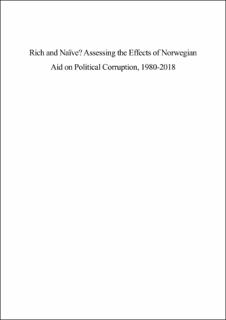| dc.description.abstract | The effectiveness of aid is heatedly debated in academia and policy circles. Annually, billions of dollars are transferred from industrialized countries to developing countries out of moral and practical concerns. Can aid from Norway, a country apparently with little strategic interests, a great deal of political consensus in support of aid, and much wealth, make a difference towards achieving better political governance in the poorer world? Using data on bilateral – and good governance aid per capita as measures of the value of aid to recipients, and novel data on political corruption, we find that aid from Norway associates negatively with political corruption, whereas total aid from all donors associates positively. The substantive impacts of these effects, however, are minimal. More sophisticated analyses accounting for selection effects and endogeneity suggest that Norwegian aid is perhaps following good governance rather than causing it. This finding, while not supporting aid optimism, might somehow comfort Norwegian taxpayers who might rest assured that their money is not unduly benefiting the corrupt. While there is no support for the extremely pessimistic view of Norway’s generosity towards the poorer world, one might still question its instrumental value if it only follows success rather than causes it. | en_US |
